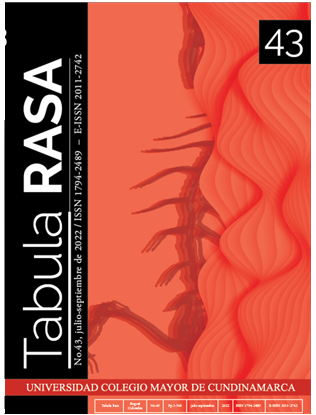El Chocó y las mitologías del oro
Mythologies of gold in Chocó
Mostrar biografía de los autores
«El Chocó y las mitologías del oro», explora las formas en las cuales la producción cultural de y sobre esta región colombiana reflexiona sobre el papel del oro como sustancia material y simbólica con un fuerte impacto en su configuración racial, social y ambiental. A través de la lectura de una colección de narrativas donde el oro aparece como una mercancía incrustada en la vida, los caminos y los destinos de quienes transitan la selva, los ríos y las ciudades chocoanas, se reflexiona sobre las representaciones en la tradición oral, la literatura, el periodismo y el cine de la exuberancia y perturbación que este metal ha causado y sigue causando en esta región. El texto argumenta que la transmisión de historias sobre el oro en un lugar donde las personas han estado condenadas a cumplir con las demandas de una economía extractiva contribuye a una larga historia de construcción de esta región como un «espacio virtual» en el imaginario nacional.
Visitas del artículo 149 | Visitas PDF 59
Descargas
- Appelbaum, N. P. (2003). Muddied Waters: Race, Region, and Local History in Colombia, 1846–1948. Durham: Duke University Press.
- Asher, K. (2009). Black and Green: Afro-Colombians, Development, and Nature in the Pacific Lowlands. Durham: Duke University Press.
- Barbas-Rhoden, L. (2014). Hacia una ecocrítica transnacional: aportes de la filosofía y crítica cultural latinoamericanas a la práctica ecocrítica. Revista de Crítica Literaria Latinoamericana, 79, 79-96.
- Botero Restrepo, J. (1986). Andágueda y Café exasperación. Medellín: Eafit.
- Escobar, A. (2008). Territories of Difference: Place, Movements, Life, Redes. Durham: Duke University Press.
- Escobar, A. & Pedro, A. (1994). Modernización: una propuesta alternativa para el Pacífico colombiano. América Latina Hoy, 7, 39-48.
- Friedemann, N. & Vanín, A. (1991). El Chocó: magia y leyenda. Bogotá: Litografia Arco.
- García Márquez, G. (1954). El Chocó que Colombia desconoce. El Espectador. Septiembre de 1954: s.p.
- Hinestrosa, J. H. (director). (2012). Chocó [cinta cinematográfica] Colombia.
- Hoyos, J. J. (1994). El oro y la sangre. Bogotá: Planeta.
- Mejía Vallejo, M. (1986). Introducción. Andágueda y Café exasperación (pp.1-7). Medellín: Eafit
- Meza Ramírez, C. M. (2010). Tradiciones elaboradas y modernizaciones vividas por pueblos afrochocoanos en la vía al mar. Bogotá: Instituto Colombiano de Antropología e Historia.
- Ospina, M. (2017). Natural Plots: The Rural Turn in Contemporary Colombian Cinema. In A. F. Castro, A. Herrero-Olaizola & C. Rutter-Jensen (Eds.). Territories of Conflict: Traversing Colombia through Cultural Studies (pp.248-266). Cambridge: Cambridge University Press.
- Palacios, A. (2014). La selva y la lluvia. Bogotá: Intermedio.
- Ronderos, M. T. (2011). La fiebre minera se apoderó de Colombia. Revista Semana 6 Sept. 2011 s. p.
- Santos Molano, E. (2014). Introducción. La selva y la lluvia (pp.13-24). Bogotá: Intermedio.
- Serje, M. (2005). El revés de la nación: territorios salvajes, fronteras y tierras de nadie. Bogotá: Universidad de los Andes.
- Striffler, S. & Moberg, M. (Eds.). (2003). Banana Wars: Power, Production, and History in the Americas. Durham, NC: Duke University Press.
- Taussig, M. (2009). My Cocaine Museum. Chicago: University of Chicago Press.
- Vanín, A. (1996). Lenguaje y modernidad. En A. Escobar & A. Pedrosa (Eds.). Pacífico ¿Desarrollo o diversidad? Estado, capital y movimientos sociales en el Pacífico Colombiano (pp.41-65). Bogotá: Cerec y Ecofondo.
- Wade, P. (2002). Introduction: The Colombian Pacific in Perspective. Journal of Latin American Anthropology, 7(2), 2-33.
- Yacup, S. (1993). Litoral recóndito. Medellín: Drake.








